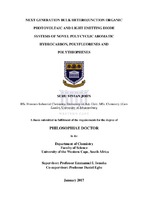| dc.contributor.advisor | Iwuoha, Emmanuel I | |
| dc.contributor.author | John, Suru Vivian | |
| dc.date.accessioned | 2018-07-26T09:16:36Z | |
| dc.date.available | 2018-08-31T22:10:06Z | |
| dc.date.issued | 2017 | |
| dc.identifier.uri | http://hdl.handle.net/11394/6114 | |
| dc.description | Philosophiae Doctor - PhD (Chemistry) | |
| dc.description.abstract | In these times of diminishing reserve of fossil fuel, the development of novel - green or
renewable? technologies to meet the increasing worldwide demand for energy is of great
importance. The sun is the largest carbon free source of energy and an infinite source of
renewable energy. However, except for the expensive inorganic crystalline silicon
photovoltaic cells, this source of energy has not been utilized. The field of organic
photovoltaic cell has made impressive progress in the last few years with the tremendous
efforts of researchers working tirelessly to develop organic materials for solar energy
conversion. Organic conjugated materials have the advantage of low cost, light weight,
process-ability and good flexibility over inorganic materials. They have attracted wide
academic and industrial interest due to their promise as semiconductors for photovoltaic
applications. Design of advanced organic conjugated materials with the ability to absorb light
from the sun and convert it into useful and storable form has and still is one of the most
important goals of researchers in the field of renewable energy. This work describes a
number of novel exciting and promising materials based on polycyclic aromatic compounds
(PACs) for organic photovoltaic cells and organic light emitting diodes. | |
| dc.language.iso | en | |
| dc.publisher | University of the Western Cape | |
| dc.title | Next generation bulk Heterojunction organic Photovoltaic and light emitting diode sytems of Novel Polycyclic Aromatic Hydrocarbon, Polyfluorenes and Polythiophenes | |
| dc.rights.holder | University of the Western Cape | |

